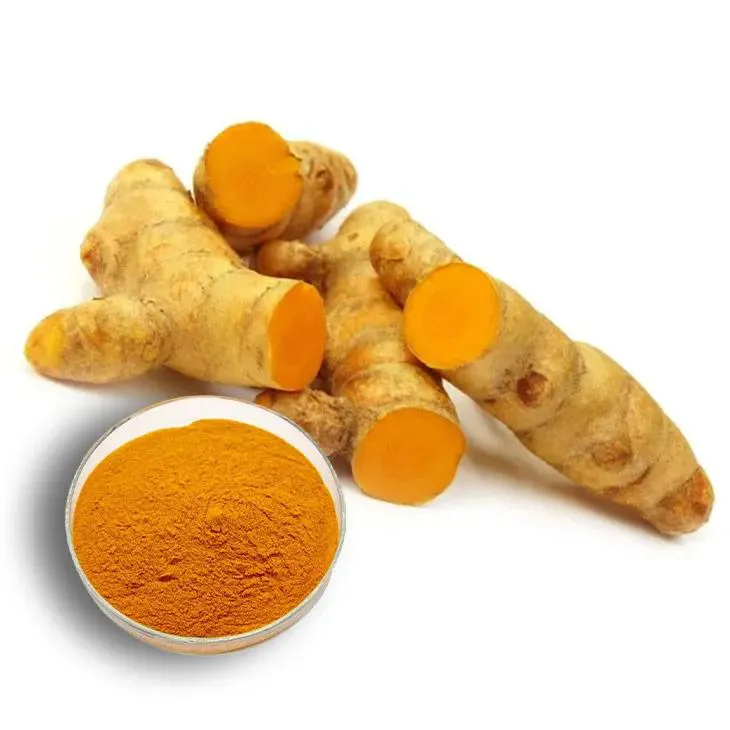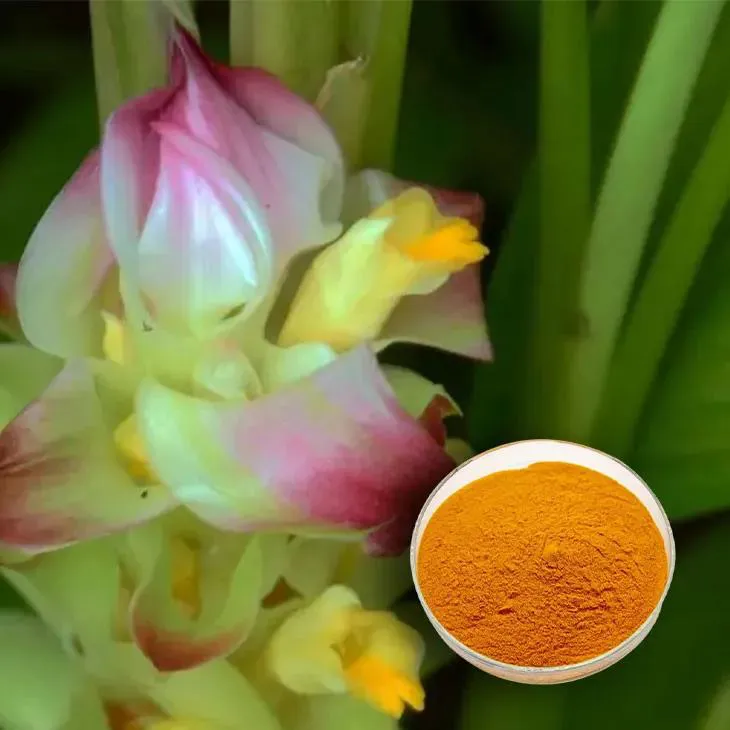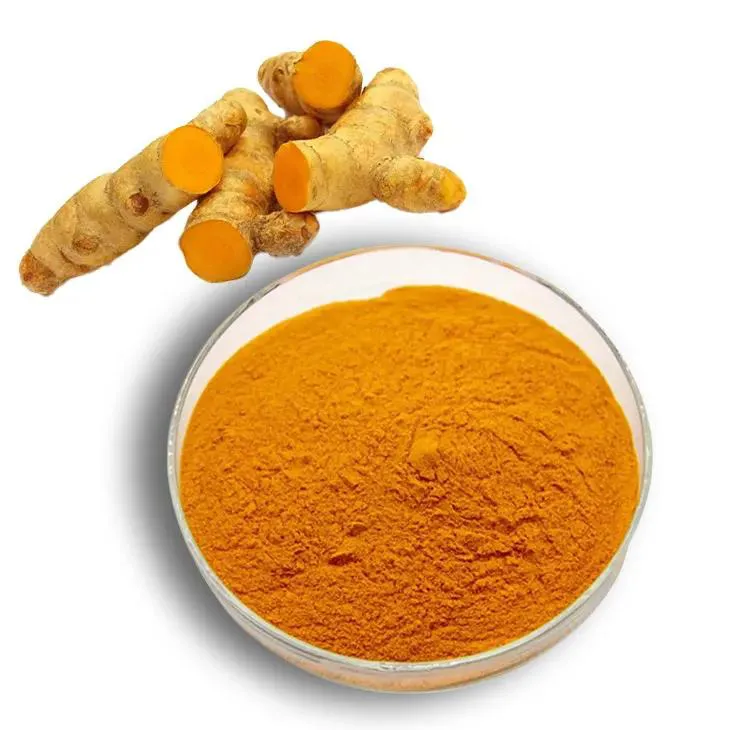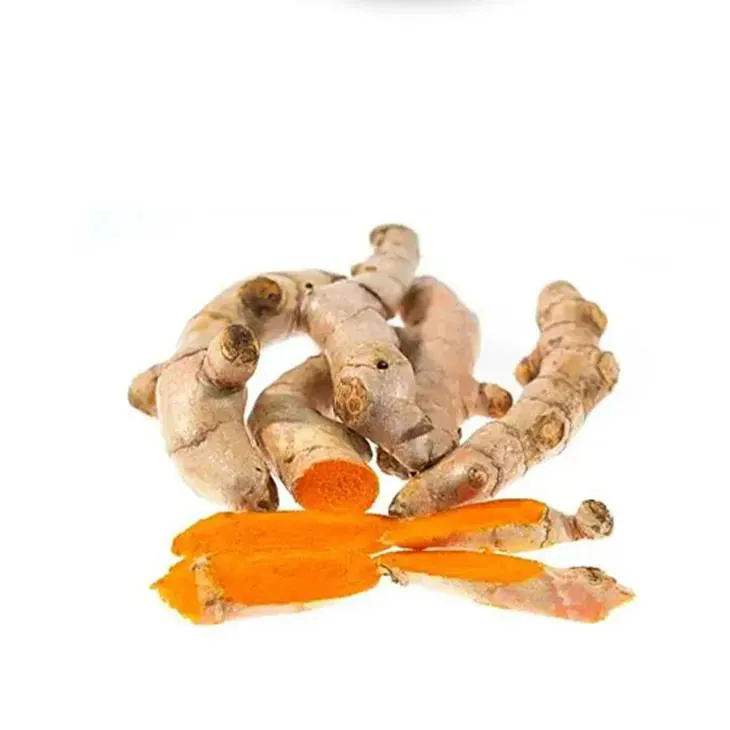- 0086-571-85302990
- sales@greenskybio.com
Unlocking the Potential of Turmeric: The Economic Viability of a Curcumin Extraction Plant
2024-08-10

1. Introduction
Turmeric, a golden - hued spice that has been used for centuries in traditional medicine and cooking, is now emerging as a significant player in the global economic arena. At the heart of turmeric's potential lies Curcumin, a bioactive compound with a plethora of health benefits. The establishment of a Curcumin extraction plant centered around turmeric is not just a promising business venture but also an exploration into the untapped economic potential of this ancient spice.

2. The Rich Properties of Turmeric
2.1. Culinary Significance
- Turmeric is a staple in many cuisines, especially in South Asian, Middle Eastern, and North African cooking. Its distinct flavor, a warm, earthy, and slightly bitter taste, adds depth and color to a wide variety of dishes. For example, in Indian cuisine, it is a key ingredient in curries, dals, and rice preparations.
- It is also used in the preparation of pickles, chutneys, and marinades. The bright yellow color it imparts to food not only makes the dishes visually appealing but also serves as an indicator of its presence in the recipe.
- Traditionally, turmeric has been used to treat various ailments. It has anti - inflammatory properties, which are attributed to Curcumin. This makes it potentially useful in the management of conditions such as arthritis, where inflammation is a major factor.
- It also has antioxidant properties. Antioxidants are substances that can prevent or slow damage to cells caused by free radicals. In the context of modern medicine, this has led to increased research on turmeric's potential role in preventing chronic diseases like cancer, heart disease, and neurodegenerative disorders.
- Furthermore, turmeric has been used in traditional medicine for digestive problems. It can stimulate bile production, which aids in digestion, and has antimicrobial properties that may help in treating gastrointestinal infections.

3. Curcumin: The High - Value Component
3.1. Chemical Properties
- Curcumin is a polyphenol, which gives it its antioxidant and anti - inflammatory properties. Chemically, it has a unique structure that allows it to interact with various biological molecules in the body.
- It is relatively stable under normal conditions but can be sensitive to factors such as light, heat, and pH. Understanding these chemical properties is crucial for the extraction and preservation of curcumin in a commercial extraction plant.
- As mentioned earlier, curcumin's anti - inflammatory effects are well - studied. It can modulate the body's inflammatory response by inhibiting certain enzymes and signaling pathways involved in inflammation. This has led to its exploration as a natural alternative to non - steroidal anti - inflammatory drugs (NSAIDs), which may have side effects with long - term use.
- Regarding its antioxidant capabilities, curcumin can scavenge free radicals and protect cells from oxidative damage. This is important in the context of preventing diseases associated with oxidative stress, such as aging - related disorders.
- Recent research has also suggested that curcumin may have potential in improving brain health. It may cross the blood - brain barrier and has been studied for its role in reducing the risk of neurodegenerative diseases like Alzheimer's and Parkinson's. It may also have antidepressant - like effects, although more research is needed in this area.

4. Market Trends
4.1. Growing Demand for Natural Products
- In recent years, there has been a significant shift in consumer preferences towards natural products. Consumers are increasingly aware of the potential side effects of synthetic drugs and are seeking natural alternatives for health and wellness. Curcumin, being a natural compound with multiple health benefits, is well - positioned to meet this demand.
- The demand for natural products is also driven by the trend towards clean - label and minimally - processed foods. Curcumin can be used as a natural colorant and flavor enhancer in the food industry, replacing synthetic additives. This is not only appealing to health - conscious consumers but also meets the regulatory requirements for clean - label products in many countries.
- The nutraceutical market, which combines the concepts of nutrition and pharmaceuticals, has been growing steadily. Curcumin - based supplements are becoming popular as they offer a convenient way for consumers to incorporate the health benefits of curcumin into their daily routine. These supplements are available in various forms, such as capsules, tablets, and powders.
- In the dietary supplement market, curcumin is often marketed for its anti - inflammatory, antioxidant, and potential disease - prevention properties. The market is expected to continue to expand as more research on curcumin's health benefits is published and consumer awareness increases.
- Curcumin is also finding its way into the cosmetic and skincare industries. Its antioxidant properties make it a valuable ingredient in anti - aging products. It can help protect the skin from environmental damage, such as UV radiation and pollution, and may also have anti - inflammatory effects on the skin, which can be beneficial for conditions like acne and eczema.
- Many cosmetic companies are now incorporating curcumin into their product formulations, either as a standalone ingredient or in combination with other natural compounds. This trend is likely to continue as consumers demand more natural and effective skincare solutions.

5. Competitive Advantages of a Curcumin Extraction Plant
5.1. Source of Raw Material
- Turmeric is widely available, especially in tropical and subtropical regions. This ensures a relatively stable supply of raw material for the extraction plant. Many countries, such as India, Indonesia, and Thailand, are major producers of turmeric, and establishing a plant in or near these regions can reduce transportation costs and ensure the freshness of the raw material.
- Moreover, some regions may have specific varieties of turmeric that are rich in curcumin. For example, the Alleppey variety in India is known for its high curcumin content. By sourcing from these regions, the extraction plant can produce high - quality curcumin.
- Advances in extraction technology have made it possible to obtain high - purity curcumin more efficiently. Modern extraction methods, such as supercritical fluid extraction and microwave - assisted extraction, can increase the yield of curcumin while minimizing the use of solvents and reducing the extraction time.
- These innovative extraction techniques also help in preserving the bioactivity of curcumin. Since curcumin's health benefits are closely related to its bioactive form, maintaining its integrity during extraction is crucial for the quality of the final product.
- A Curcumin Extraction plant can implement strict quality control measures. This includes testing the raw material for curcumin content, purity, and contaminants. By ensuring high - quality products, the plant can build a good reputation in the market and gain a competitive edge.
- Product differentiation is also possible. The plant can produce different grades of curcumin products, depending on the application. For example, a higher - purity curcumin can be targeted for the pharmaceutical industry, while a lower - purity but more cost - effective product can be sold for use in the food or cosmetic industries.
6. Cost - Benefit Analysis
6.1. Initial Investment
- The establishment of a Curcumin Extraction plant requires a significant initial investment. This includes the cost of land, building construction, and the purchase of extraction equipment. The cost of equipment can vary depending on the scale of the plant and the extraction technology used. For example, supercritical fluid extraction equipment is relatively expensive but can offer higher yields and better product quality.
- There are also costs associated with obtaining the necessary licenses and permits, as well as hiring and training staff. Initial marketing expenses to promote the plant's products should also be considered.
- Operational costs include the cost of raw materials, energy consumption for the extraction process, and maintenance of equipment. The cost of turmeric as a raw material can fluctuate depending on factors such as crop yields, market demand, and international trade policies.
- Energy costs can be a significant factor, especially if the extraction process requires a large amount of heat or electricity. However, with the development of more energy - efficient extraction technologies, these costs can be reduced over time.
- The main revenue stream for a curcumin extraction plant comes from the sale of curcumin products. These products can be sold in different markets, such as the nutraceutical, food, cosmetic, and pharmaceutical industries. The price of curcumin products can vary widely depending on their purity, quality, and application.
- By - products of the extraction process can also generate additional revenue. For example, the remaining turmeric residue after curcumin extraction can be used in the production of animal feed or as a natural fertilizer, providing an additional source of income for the plant.
7. Challenges and Solutions
7.1. Regulatory Hurdles
- The curcumin extraction industry is subject to various regulatory requirements, especially when it comes to products intended for human consumption or use in the pharmaceutical and nutraceutical sectors. These regulations can vary from country to country, and compliance can be a complex and costly process.
- To overcome these regulatory hurdles, the extraction plant should invest in regulatory affairs expertise. This includes hiring professionals who are well - versed in food, drug, and cosmetic regulations to ensure that all products meet the required standards. Additionally, the plant should stay updated on regulatory changes and adapt its production processes accordingly.
- In some applications, curcumin may face competition from synthetic alternatives. For example, in the food industry, synthetic colorants and flavor enhancers may be cheaper and more readily available. To compete with these synthetic alternatives, the curcumin extraction plant needs to focus on product quality and marketing the unique benefits of curcumin.
- Highlighting curcumin's natural origin, health benefits, and potential for clean - label products can help differentiate it from synthetic alternatives. Additionally, continuous research and development to improve the extraction process and product quality can make curcumin more competitive in the market.
- The market for curcumin products can be volatile, influenced by factors such as changes in consumer preferences, new research findings, and economic conditions. For example, if a new study questions the effectiveness of curcumin for a particular health benefit, it could lead to a temporary decline in demand.
- To mitigate market volatility, the extraction plant should diversify its product portfolio. By offering a range of curcumin - based products for different applications and markets, the plant can spread its risk. Additionally, building strong relationships with customers and suppliers can help the plant better withstand market fluctuations.
8. Conclusion
The establishment of a curcumin extraction plant centered around turmeric holds great economic potential. With the rich properties of turmeric, the high - value curcumin it contains, favorable market trends, and several competitive advantages, such a plant can be a profitable venture. However, it also faces challenges, such as regulatory hurdles, competition from synthetic alternatives, and market volatility. By addressing these challenges through appropriate strategies, a curcumin extraction plant can unlock the full economic potential of turmeric and contribute to the growth of the natural products industry.
FAQ:
1. What are the main properties of turmeric that make curcumin extraction economically viable?
Turmeric has several properties that contribute to the economic viability of curcumin extraction. Firstly, turmeric is widely available in many regions, which helps in ensuring a steady supply of raw material. Secondly, it has been used for centuries in traditional medicine, which has led to a growing interest in its active compound curcumin in modern applications. Curcumin itself has antioxidant, anti - inflammatory, and antimicrobial properties, making it highly valuable in the pharmaceutical, nutraceutical, and cosmetic industries.
2. How does the market trend for curcumin - based products influence the economic viability of a curcumin extraction plant?
The market trend for curcumin - based products is highly favorable for the economic viability of a curcumin extraction plant. There is an increasing consumer demand for natural and plant - based products. Curcumin, being a natural compound with multiple health benefits, is in high demand in the health and wellness sector. The growing popularity of dietary supplements, functional foods, and natural cosmetics containing curcumin has led to an expanding market. This allows the extraction plant to have a ready market for its product, ensuring profitability.
3. What are the competitive advantages of establishing a curcumin extraction plant?
One competitive advantage is the relatively low cost of raw turmeric compared to the high value of the extracted curcumin. Another advantage is the potential for vertical integration. The plant can control the entire process from turmeric sourcing to curcumin extraction and product formulation. Additionally, with proper quality control, it can produce high - purity curcumin, which is highly sought after in the market. There may also be opportunities for innovation in extraction techniques, which can lead to cost savings and a more efficient production process compared to competitors.
4. What are the challenges in establishing a curcumin extraction plant from an economic perspective?
From an economic perspective, some challenges include the initial investment required for setting up the plant, which includes the cost of equipment, infrastructure, and research and development. There may also be challenges related to competition from other curcumin producers or alternative products. The price volatility of turmeric as a raw material can also impact costs. Moreover, regulatory requirements for food and pharmaceutical - grade curcumin can be complex and costly to comply with, which may affect the economic viability.
5. How can a curcumin extraction plant ensure long - term profitability?
To ensure long - term profitability, a curcumin extraction plant can focus on product quality and innovation. By constantly improving extraction methods, it can increase the purity and yield of curcumin. It should also keep up with market trends and invest in research and development to diversify its product range. For example, developing new formulations for different applications such as in the treatment of specific diseases or in novel cosmetic products. Additionally, building strong relationships with suppliers and customers can help in ensuring a stable supply chain and market access.
Related literature
- The Therapeutic Potential of Curcumin: New Insights"
- "Turmeric and Curcumin: From Traditional Medicine to Modern Drug Discovery"
- "Economic Viability of Spice - Based Industries: A Case Study of Turmeric"
- ▶ Hesperidin
- ▶ Citrus Bioflavonoids
- ▶ Plant Extract
- ▶ lycopene
- ▶ Diosmin
- ▶ Grape seed extract
- ▶ Sea buckthorn Juice Powder
- ▶ Fruit Juice Powder
- ▶ Hops Extract
- ▶ Artichoke Extract
- ▶ Mushroom extract
- ▶ Astaxanthin
- ▶ Green Tea Extract
- ▶ Curcumin
- ▶ Horse Chestnut Extract
- ▶ Other Product
- ▶ Boswellia Serrata Extract
- ▶ Resveratrol
- ▶ Marigold Extract
- ▶ Grape Leaf Extract
- ▶ New Product
- ▶ Aminolevulinic acid
- ▶ Cranberry Extract
- ▶ Red Yeast Rice
- ▶ Red Wine Extract
-
Genistein
2024-08-10
-
Golden Seal Extract
2024-08-10
-
Dandelion Leaf Extract
2024-08-10
-
Selenium yeast
2024-08-10
-
Hawthorn powder
2024-08-10
-
Curcuma Longa Extract
2024-08-10
-
Grape Seed Extract
2024-08-10
-
Polygonum multiflorum extract
2024-08-10
-
Alisma Extract
2024-08-10
-
Berberis aristata Extract
2024-08-10





















